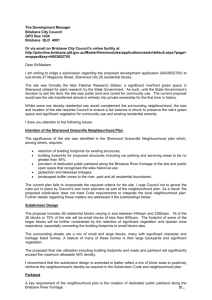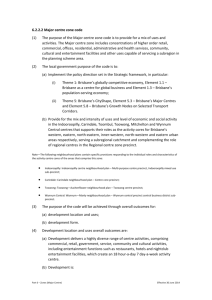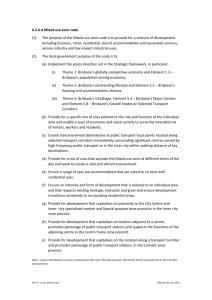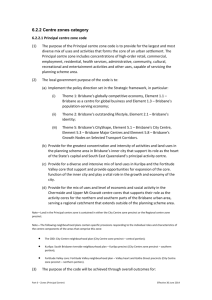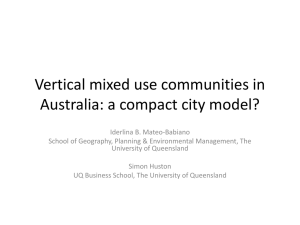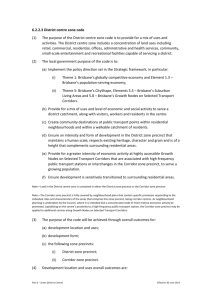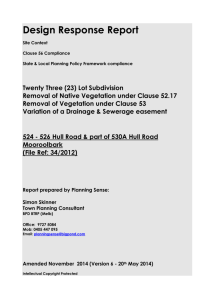5. Guide to subdividing land
advertisement
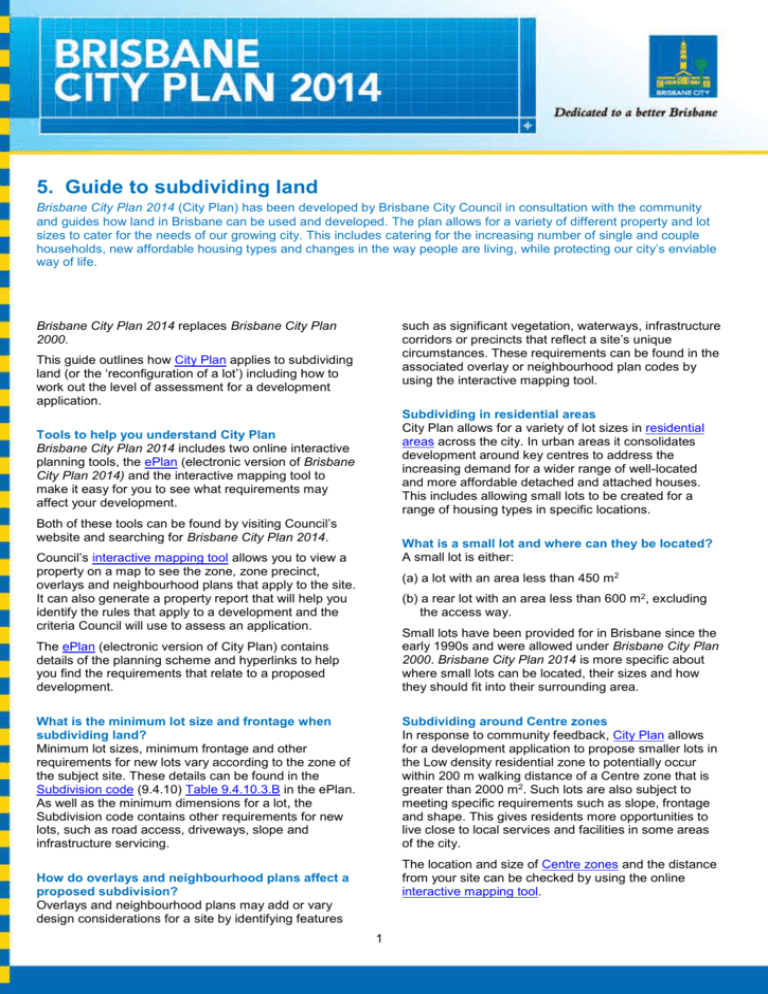
5. Guide to subdividing land Brisbane City Plan 2014 (City Plan) has been developed by Brisbane City Council in consultation with the community and guides how land in Brisbane can be used and developed. The plan allows for a variety of different property and lot sizes to cater for the needs of our growing city. This includes catering for the increasing number of single and couple households, new affordable housing types and changes in the way people are living, while protecting our city’s enviable way of life. Brisbane City Plan 2014 replaces Brisbane City Plan 2000. such as significant vegetation, waterways, infrastructure corridors or precincts that reflect a site’s unique circumstances. These requirements can be found in the associated overlay or neighbourhood plan codes by using the interactive mapping tool. This guide outlines how City Plan applies to subdividing land (or the ‘reconfiguration of a lot’) including how to work out the level of assessment for a development application. Subdividing in residential areas City Plan allows for a variety of lot sizes in residential areas across the city. In urban areas it consolidates development around key centres to address the increasing demand for a wider range of well-located and more affordable detached and attached houses. This includes allowing small lots to be created for a range of housing types in specific locations. Tools to help you understand City Plan Brisbane City Plan 2014 includes two online interactive planning tools, the ePlan (electronic version of Brisbane City Plan 2014) and the interactive mapping tool to make it easy for you to see what requirements may affect your development. Both of these tools can be found by visiting Council’s website and searching for Brisbane City Plan 2014. What is a small lot and where can they be located? A small lot is either: Council’s interactive mapping tool allows you to view a property on a map to see the zone, zone precinct, overlays and neighbourhood plans that apply to the site. It can also generate a property report that will help you identify the rules that apply to a development and the criteria Council will use to assess an application. (a) a lot with an area less than 450 m2 (b) a rear lot with an area less than 600 m2, excluding the access way. The ePlan (electronic version of City Plan) contains details of the planning scheme and hyperlinks to help you find the requirements that relate to a proposed development. Small lots have been provided for in Brisbane since the early 1990s and were allowed under Brisbane City Plan 2000. Brisbane City Plan 2014 is more specific about where small lots can be located, their sizes and how they should fit into their surrounding area. What is the minimum lot size and frontage when subdividing land? Minimum lot sizes, minimum frontage and other requirements for new lots vary according to the zone of the subject site. These details can be found in the Subdivision code (9.4.10) Table 9.4.10.3.B in the ePlan. As well as the minimum dimensions for a lot, the Subdivision code contains other requirements for new lots, such as road access, driveways, slope and infrastructure servicing. Subdividing around Centre zones In response to community feedback, City Plan allows for a development application to propose smaller lots in the Low density residential zone to potentially occur within 200 m walking distance of a Centre zone that is greater than 2000 m2. Such lots are also subject to meeting specific requirements such as slope, frontage and shape. This gives residents more opportunities to live close to local services and facilities in some areas of the city. The location and size of Centre zones and the distance from your site can be checked by using the online interactive mapping tool. How do overlays and neighbourhood plans affect a proposed subdivision? Overlays and neighbourhood plans may add or vary design considerations for a site by identifying features 1 Subdividing in the Low-medium density residential zone You can subdivide land into smaller lots of between 180-260 m2 in the Low-medium density residential zone depending on the zone precincts. The subdivision is subject to a development application being assessed against all relevant aspects of the Subdivision code. The Low medium density residential zone is located close to centres, facilities, open space and public transport. Smaller lots will allow for the development of more housing variety in these highly accessible locations. Acceptable subdivision in the Low density residential zone The following diagram shows where properties are within 200 metres walking distance of a Centre zone with a site area of more than 2000 m2. To determine the location of the Low medium density residential zone and its three zone precincts, use the interactive mapping tool on Council’s website. Small lot design Smaller lots created by a subdivision are intended to provide for houses built in accordance with City Plan’s Dwelling house (small lot) code. This code sets reasonable standards that maintain amenity for potential residents and surrounding neighbours. A development application for the proposed subdivision and any applications for houses on the newly-created lots do not need to occur together. Subdividing in the Rural residential zone City Plan includes a new zone called Rural residential. While City Plan Subdivision code includes provisions for lots in this zone, such as a minimum lot size of one hectare, land in this zone is also affected by the State Government planning regulatory provisions (SPRP) for the South East Queensland Regional Plan. Council does not set these requirements so reference to the Queensland Planning Provisions (QPP) when considering subdivision in the Rural residential zone is imperative. What is walking distance? Walking distance is defined as the distance between two places, measured from reasonable pedestrian access points and along roads with verges, off-road pathways or other reasonable pedestrian connections. The following diagrams provide guidance on the relationship between subdivision lot sizes, walking distance and Centre zone dimensions. Larger subdivisions For developments on larger sites, such as those greater than one hectare in an Emerging community zone or greater than 7000 m2 in a Low density residential zone, creating 20 or more sites, or opening a new road, a structure plan may need to be submitted. A structure plan is intended to show how the proposed development fits in with the surrounding area. The Subdivision code and the Structure planning scheme policy contain more information on requirements for structure plans. Overlays also identify relevant factors development applications must address. Development in these areas may need to meet requirements including the range of lot sizes, average lot size and the minimum density of lots. For example, City Plan aims for a minimum of 18 dwellings per hectare in the Emerging community and Low density residential zones, and 24 dwellings per hectare in the Low-medium density residential zone. Is a development application required to subdivide land? An application will need to be lodged with Council to subdivide land. This will be subject to either code assessment or impact assessment. Queensland Government-wide compliance assessment for one into two subdivisions, and the associated operational work code, do not apply in Brisbane as at least one overlay applies to all sites. 2 CA14-324450 Determining the level of assessment Once you have details of a site, the level of assessment for subdivision is determined by Part 5.6 of the ePlan. Prescribed secondary codes include assessment criteria relating to stormwater, carparking, filling, landscaping and other matters. Part 5 of the ePlan defines development that is exempt from the planning scheme and identifies the rules for determining the level of assessment for development that is otherwise subject to the planning scheme. To identify the level of assessment, first refer to Part 5.6 levels of assessment - Reconfiguring a lot and find the level of assessment applicable to the zone or zone precinct of the site. In addition to the above, determining the applicable assessment criteria involves the following steps. Overlays and neighbourhood plans may further change the level of assessment that applies to the zone or zone precinct. Part 5.3.1 of the scheme outlines the process for determining this, as summarised below. Determine whether a neighbourhood plan changes the level of assessment in the zone/precinct by referring to the neighbourhood plan levels of assessment in Part 5.9 of the planning scheme. A summary table of all neighbourhood plans, and whether they change the level of assessment (listed in the zones) for each component of development, is provided at the beginning of Part 5.6 (Table 5.6.1). Each neighbourhood plan then has its own table outlining in further detail the level of assessment for various development (if changed), and the applicable assessment criteria (relevant codes). Determine whether one or more overlays change the level of assessment in the zone/precinct by referring to the levels of assessment in Part 5.10. 1. Identify the zone: Check the level of assessment to determine the applicable code(s) for the development. 2. Identify if the site is within a neighbourhood plan (and any precinct) and check if the neighbourhood plan varies the level of assessment in Part 5, or if additional codes apply. 3. Identify if the site is affected by an overlay and check if the overlay varies the level of assessment in Part 5, or if additional codes apply. More information For more information about City Plan visit www.brisbane.qld.gov.au and search for Brisbane City Plan 2014, email the project team at newcityplan@brisbane.qld.gov.au or phone Council on (07) 3403 8888. Disclaimer: The content of this information sheet is a summary and has been prepared to assist the reader to understand City Plan. Please refer to the full City Plan document, entitled Brisbane City Plan 2014, on Council’s website for further detail. Part 5.3.2 of the planning scheme outlines the specific rules for determining the level of assessment. The key rules for determining the hierarchy of assessment levels are shown below. Determining applicable codes The assessment criteria relevant to a development are identified within the assessment criteria column of the relevant level of assessment table in Part 5 of the planning scheme. There are also prescribed secondary codes listed in Section 5.3.5 that apply to a wide range of assessable developments across a number of zones. 3 CA14-324450


